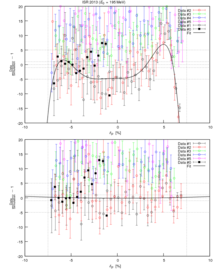Meeting No. 12
The analysis of 195MeV setting
After applying the new vertex correction, the 195MeV results were no longer consistent. The bottom
plot shows, how the elastic point is lower than the rest of the points. Hence, we decided to investigate
a bit more in order to see, if this discrepancy is real or not. I have checked the contributions of snout,
but these corrections seem ok. A change there would destroy the 330MeV and 495MeV settings. hence, I looked
forward. Then I made a very detailed inspection of our results (see plots below), and discovered, that
that 330MeV and 195MeV (especially) have a hidden oscillation inside the data. This oscillation was observed
already at 495MeV setting and was related to the detection efficiency because it appears always at the same
position in the detector. However, the effect seems to be increasing with the smaller energy. Since we were
always using the same correction, we did not correct the whole thing our.
1.) 
2.)  3.)
3.) 
Ratio plots:
Therefore I revisited the analysis of the efficiency. The following plot shows the results for
the 495MeV setting after the correction was applied. Here we do not see any fluctuation any more:
4.) 
However, for the 330MeV setting some fluctuation was still present, causing some of the points at
the edge of the acceptance to be too high. Then I removed the correction to see the whole effect
and to find new/proper correction. With the new fit the distribution looks better:
5.)  6.)
6.)  7.)
7.)  8.)
8.) 
The same analysis was done also for the 195MeV setting. Here the effect is even larger. Again,
the new correction was applied. With the correction I took out only the fluctuation. I did not
change the offset, so that we do not mess with the cross-section.
9.)  10.)
10.)  11.)
11.) 
However, although this correction must be related to the apparatus, I still do not understand it.
New Results:
With the improved corrections, the results look more promising. The 195MeV points lowered
and now also the 195MeV settings are consistent. However, looking at the results, small portion
of the fluctuation is still in, at the negative deltas smaller than -6%. I believe this has
to do with the fact, that when I applied the correction, I did not match the offsets of the settings in the center.
Consequently, the correction is a bit diluted. With the 495MeV setting this was not a problem,
since the simulation and data agreed to an order better than 2%. For the 495MeV and 330MeV
settings the correction is larger.
12.)  13.)
13.)  14.)
14.) 
Real and Virtual corrections.
Here are my notes on the real and virtual corrections. With the help of these
notes I would like to discuss with you the vertex correction that I applied so that
we can decide if this is right or not.
NotesOn2ndOrderCorrection.PDF
NotesOnTheVertexCorrection.pdf
Here is also the size of the second order radiative correction that we use. The
error is estimated as the size of the 3rd+others order correction
15.) 
Last modified 27.5.2016

 3.)
3.) 

 6.)
6.)  7.)
7.)  8.)
8.) 
 10.)
10.)  11.)
11.) 
 13.)
13.)  14.)
14.) 
